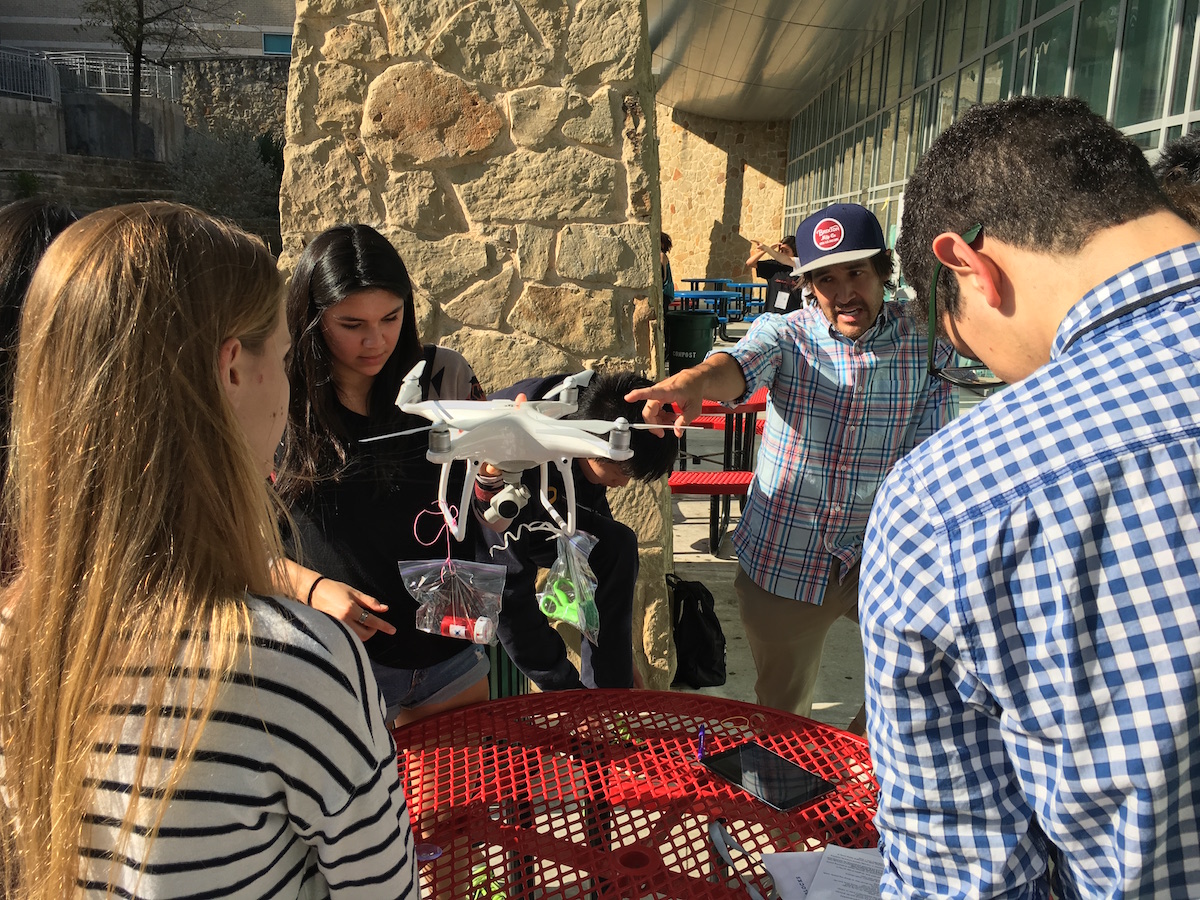
Blog Articles
DroneBlocks Medical Mission Challenge at TEDxYouth Austin
February 13, 2017 — 5 minutes
We were honored to be invited to TEDxYouth Austin this past weekend. Thanks to Kush Desai and the youth leaders of TEDxYouth Austin for arranging the event and asking DroneBlocks to be a part of the xLabs experience.
I wanted to take a few minutes and share the interactive session we planned for the students. We setup a DroneBlocks challenge that we called the “Medical Mission”. The objective was for students to deliver medication via drone to an elderly lady across the river. You can read more about the challenge here. Feel free to use this with your students and modify as necessary, and remember that our introductory course that teaches programming with drones is available for free here.
The goals of the challenge were:
– Safely attach medication to the DJI Phantom 4
– Estimate distance between takeoff and landing pads
– Program a DroneBlocks mission to safely fly from takeoff to landing pad
– Take a photo of the surrounding area before landing
Here is what the box of supplies looked like. Marisa Vickery put this box of supplies together and it was amazing to see all the different ways the medication was mounted to the Phantom 4.

In the box there was a pill bottle with jelly beans and the DroneBlocks logo on it. This is the medication we will be delivering. You can get creative and print labels with your school or club logo and put them on the medication bottle. Students love thinking outside the box. Marisa also added tape, ziploc bags, rubber bands, a suction cup, clothes pin, and several other items that you can see in the photo.
As part of the mission the students have to estimate the distance from the takeoff and landing pads. It was neat to see all the different methods students used to estimate the flight distance.

As a side note, Marisa and her son created these incredible DroneBlocks helipads that we used during the challenge.


These mats can be found at your local Home Depot for about $15. Marisa went the extra mile and used her decal printer to put the DroneBlocks logo on the mat. If you have a decal printer then consider getting two of these mats and putting your school or club logo on them. It will look amazing!
The students were given 15 minutes to figure out how to mount the medication to the Phantom 4 as well as program their DroneBlocks mission. Here are some creative ways the students tried mounting the medication to the drone:

Medication suspended between landing legs with rubber bands

There were some very creative ways of attaching the pill bottle to the drone. I would like to point out that we strongly advise against mounting the pill bottle to the top of the drone. The biggest risk is if it comes loose during the mission and falls into one of the propellers. This would ultimately result in a crash. It was a good opportunity to explain this risk to the students and they quickly revised their mounting mechanism. These types of scenarios serve as great teaching opportunities as it relates to the safe and responsible use of drones.
While students from each team were mounting pill bottles and measuring distances, others took initiative and wrote the DroneBlocks software to get from point A to point B. For the sake of time, and due to limited space, the mission just flew the Phantom 4 with pill bottle in a straight line. Feel free to get creative with this part of the challenge if space allows. We plan on doing an upcoming challenge in a field that will allow us more flexibility.
Here is the mission that the students programmed:

The program is pretty basic but many students forgot to pitch the camera/gimbal down before taking the photo. In the mission challenge it says the drone must take a photo of the landing area before descending. We were able to review the code with students and explain what was missing. The beauty of software is that if a step is missing it can be easily added, reviewed, and tested. Here is photo from one of the missions:

I always love these straight down (aka nadir) photos. They give such great perspective of an area.
Both teams completed the missions successfully. Unfortunately we didn’t have enough space to run the challenge as we originally intended. The idea was to split into two teams and see which team could finish the challenge the fastest, and with the most accurate landing. Instead we ran each mission independently and judged solely based on accuracy (proximity to the landing pad).
As an additional extension to the challenge there were a couple of aspiring drone pilots, one from each team. We let each pilot manually fly from the takeoff to the landing pad to deliver the medication. Here is a photo of our friend Pat carrying out the manual flight challenge:

There are so many ways to get creative with this lesson and we will be working on a full lesson plan at learn.droneblocks.io for you to check out soon. Stay tuned for more mission challenges from DroneBlocks.
A special thanks to Marisa Vickery for her leadership and creativity in making this lesson interactive for the students. Be sure to follow Marisa and DroneBlocks on Twitter.
DroneBlocks is Teaching Students to Code Using Drones
Transform traditional classrooms into future-ready learning hubs with DroneBlocks. Our comprehensive drone STEM curriculum, interactive apps, and kits are designed for students at all educational levels.
- Teach real-world skills
- Learn software programming
- Learn hardware engineering
- Learn aviation principles